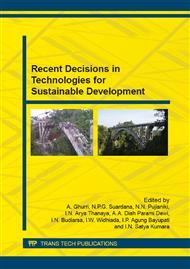[1]
J. Black, and P. Suthanaya, VKT Generated by Local Government Areas, Sydney, 1961-1996, and Projections to 2011. 25th Australian Transport Research Forum (ATRF), Canberra, 2-4 October (2002).
Google Scholar
[2]
K. Kikuchi, M. Arimura, T. Tamura, and K. Saito, Empirical Study on Optimum Allocation toward Reducing the Length of Journey to Work Trip: The Case of Sapporo City. Proceedings of the Eastern Asia Society for Transportation Studies, Vol. 8 (2011).
Google Scholar
[3]
B. Yu, J. Zhang, and A. Fujiwara, Comparative Analysis on Household Energy Consumption Behavior in Asia Megacities by Considering the Effect of Car Ownership and Self-selection. Proceedings of the Eastern Asia Society for Transportation Studies, Vol. 8 (2011).
Google Scholar
[4]
G. Kim and S. Han, Comparative Analysis of Transportation Sustainability. Journal of the Eastern Asia Society for Transportation Studies, Vol. 9 (2011) 82-97.
Google Scholar
[5]
T.B. Joewono, B.Z. Lauw and H. Hendy, Motorcycle in the West Java Province, Indonesia: Its Growth and Characteristics, Civil Engineering Dimension, Vol. 15, No. 1 (2013) 61-70.
DOI: 10.9744/ced.15.1.61-70
Google Scholar
[6]
P.A. Suthanaya, Analysis of Journey to Work Travel Behavior by Car and Bus in theSydney Metropolitan Region. Civil Engineering Dimension, Vol. 13, No. 1 (2011) 21-28.
DOI: 10.9744/ced.13.1.21-28
Google Scholar
[7]
Denpasar City Department of Transport, Evaluation of the Road Traffic Performance in Denpasar City. Research Report (2013).
Google Scholar
[8]
Denpasar Bureau of Statistics, Population, Socio-Economic and Transport Data, Denpasar (2013).
Google Scholar
[9]
W.G. Hansen, How Accessibility Shapes Land-use. Journal of the American Institute of Planners, 25 (2) (1959) 73-6.
DOI: 10.1080/01944365908978307
Google Scholar
[10]
S.B. Chung, S.H. Hur, J.H. Baek, D. Kim, and K.H. Song, Development of Accessibility Index Using Closeness Centrality. Proceedings of the Eastern Asia Society for Transportation Studies, Vol. 8 (2011) 1-10.
Google Scholar
[11]
T. Suzuki, Reduction effect of commuter traffic energy through optimization ofcommuting allocation, Operations Research, May (1994) 243-248.
Google Scholar
[12]
T. Maruyama, and N. Haradam Establishment and empirical study of an optimumcommuting allocation method that considers network congestion, Research Papers forUrban Planning, No. 38-3 (2003) 517-522.
Google Scholar
[13]
P. Waddell, Accessibility and Residential Location: The Interaction of Workplace, Residential Mobility, Tenure, and Location Choices. Proceedings of Lincoln LandInstitute Conference (1996).
Google Scholar
[14]
C.F. Lee, Statistics for Business and Financial Economics, D.C. Heath and Company, Lexington (1993).
Google Scholar


